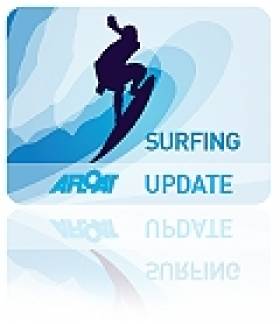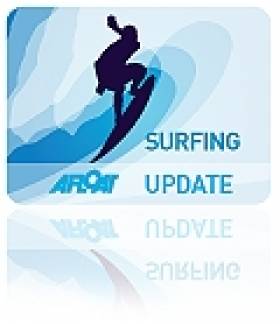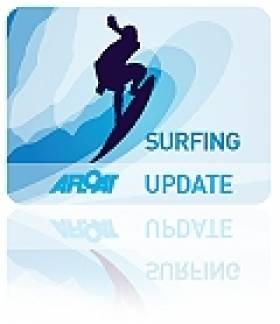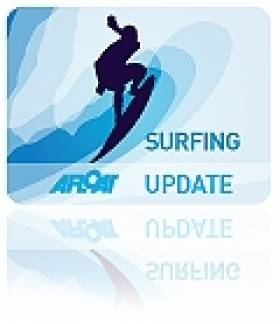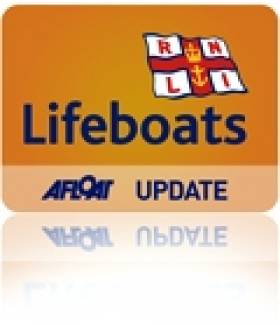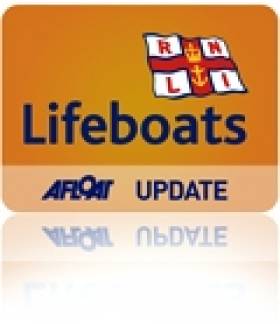Displaying items by tag: Surfing
New Surfing Exchange Project For Cornish & Irish Teens
#Surfing - A new surfing exchange programme for young people is promoting cultural relations between the UK and Ireland.
As the Cornish Guardian reports, up to 15 local teenagers will be selected to take part in the Wave Project exchange with Co Donegal, which has the aim of boosting confidence and reducing anxiety through surfing.
The first exchange takes place over next month's half-term holidays in the UK, when 13 Irish youth will stay in Newquay.
They will return the favour next spring over the Easter break when the Cornish teens will stay at a purpose-built facility on the Donegal coast.
The Cornish Guardian has more on the story HERE.
Get Up To Speed As Ireland's Surfing Season Begins
#Surfing - Summer might already be a distant memory, but Ireland's surfing season is only just getting under way.
And beyond the bigger wave hotspots like Sligo, which is set to host record-breaker Garrett McNamara at the second Surf Summit this November, there's a wealth of activity happening all around the Irish coast.
Entertainment.ie brings us a round-up of some of the best places for surfing action for all ability levels, including perhaps lesser-known haunts like the Sunny South East.
But the biggest attraction this month is surely the Battle for the Lake kitesurfing festival on Achill Island next weekend (25-27 September), with its entertaining mix of live music from up-and-coming homegrown acts and dazzling displays by Ireland's top kitesurfers.
Strandhill Tops Surfing Spots On Wild Atlantic Way
#Surfing - Strandhill in Co Sligo is the number one spot for surfing in Ireland, according to a new celebration of the best towns to catch waves along the Wild Atlantic Way.
In the words of SurfHolidays.com, the small village just six kilometres from Sligo town "is an eclectic mix of surfers, locals and travellers who have now made [it] their home. If you’re looking for a surf trip in Ireland you have found the perfect spot."
It also helps that it's not far from the northwest surfing mecca of Bundoran – which features third on this selection – not to mention the fearsome big waves off Mullaghmore Head.
Running a close second on the list is Lahinch in Co Clare, which splits the difference between the challenging Aileens big wave spot off the coast to the surf at the beach itself, which is "perfect for beginners".
Further north, just to the east of the Wild Atlantic Way's starting point, the quality surfing at Portrush gets a shout-out, as does the "mythical" wave of Inch reef near Ballybunion in Co Clare.
SurfHolidays.com has more on the story HERE.
#StandUpPaddle - Jason Conniry is set to make it a first for Cork's An Rás Mór during the Ocean to City Cork Harbour Festival this coming June bank holiday weekend - plying the long-distance rowing course by stand-up paddle board.
As the Irish Examiner reports, the former US lifeguard and longtime surfer, who now resides in Clonakilty, will attempt the shorter 13km race route on his 14ft paddle board just months after surgery for cancer.
He'll be the only 'stand-up guy' among hundreds of rowing boats, kayaks, canoes and even dragon boat teams in the annual race that stretched from Monkstown to the heart of the city in its full 28km length.
“If this goes well, next year I would love to open the race up to prone paddle boarders and we could see up to 100 entries," he said.
The Irish Examiner has more on the story HERE – and also carries news of an incredible encounter with a killer whale by a stand-up paddle boarder in New Zealand this week.
Like Reilly was lucky enough to have his GoPro to hand when the inquisitive orca swam right up to his board for a nose around.
"This one bee-lined it for me," he said of the cetacean in the video above. "He popped up about 10cm away from the back of my board. I was a bit nervous thinking, 'what's this guy going to do?'"
#Surfing - Two enterprising surfing brothers are one step closer to a £50,000 business grant from Virgin boss Richard Branson.
According to the Belfast Telegraph, Ricky and Chris Martin secured enough votes through the online 'Pitch to Rich' campaign to come first out of 897 businesses in the initial round.
And if they make it through to the final, they could present their Skunk Works Surfboards company to Branson himself, with the chance to persuade him to back their idea.
The Portrush brothers were profiled earlier this year for making the most of Ireland's growing thirst for surfing with their key concept - a custom method for manufacturing much more durable foam surfboards, or 'foamies'.
Already the duo have a manufacturing set-up in place and orders for 200 boards on the books.
But Ricky Martin, who also owns the Alive Surf School in Portrush, says pitching to Branson "could ultimately change how we do things".
The Belfast Telegraph has more on the story HERE.
Surf Meets Trad In New Video Tribute To Lahinch's Big Waves
#Surfing - Ireland's surfing scene gets another tribute in this new short film from surf-wear brand Billabong, via BreakingNews.ie.
Matching the pulsing rhythms of a trad session at Kelly's Bar with breathtaking action from the wild waves off Lahinch in Co Clare was an inspired choice for this clip, produced by the former title sponsors of the annual Big Wave Awards.
That's a contest with a local connection as Lahinch native Ollie O'Flaherty was nominated in 2012 for the massive swell he caught along with Mullaghmore regular Andrew Cotton.
This particular clip, however, features American Shane Dorian with Frenchman Benjamin Sanchis, a recent challenger for the biggest wave of all time, taking on the intimidating water walls of Aileens and Rileys.
Indoor Surfing An Option For Derry Sports Centres
#Surfing - Indoor surfing could be on the cards for Derry residents in proposals for new sports facilities the Foyleside city, as the Londonderry Sentinel reports.
A wave-machine-type "surf basin" is one of a number of options for the £20-30 million investment for development of the Templemore and Riversdale sports centres, according to Noel Munnis, head of sports and leisure at Derry City and Strabane District Council.
It would certainly be a popular feature in surfing mad Northern Ireland, what with the big waves of Portrush and Bundoran available within less than a two-hour drive.
#Surfing - No stranger to lists of the world's top surfing destinations, Bundoran has been cited yet again as a spot no waverider worth their salt will want to miss.
This time the Donegal surfing mecca – set to attract the cream of Europe's surf talent to the Sea Sessions this coming June – is included in All Day's list of 'The Amazing Waves All Surfers Want To Ride'.
"Hardcore surfing enthusiasts don’t let the cold Irish waters stop them from surfing the green waves," says the social news site, which lists Bundoran alongside lesser known sites such as Cloud Nine in the Philippines and Cornwall's Watergate Bay.
Bundoran Lifeboat Launches To Surfer In Difficulty
#Lifeboats - Yesterday evening (Monday 6 April), the volunteer crew of Bundoran RNLI were requested by the Irish Coast Guard at Malin Head to launch to a surfer in difficulty.
Shortly after 8pm, a passer-by noticed a female surfer in difficulty off Tullan Strand in Bundoran and immediately dialled 999.
Moments later the lifeboat crew were paged and within four minutes the Atlantic 85 lifeboat was launched from the pier, arriving on scene in under three minutes.
The crew brought the surfer and her surfboard on to the lifeboat and performed a quick medical check finding she was shaken but uninjured. The crew then returned to the station.
Speaking after their return, lifeboat helm Brian Gillespie said: "We are thankful to the member of the public who did the right thing by calling the coastguard.
"Darkness was beginning to fall and had it been any later the situation may have turned more dangerous. Thankfully the surfer is OK.
"As the weather is getting better, we want people to enjoy themselves but we would urge water users to exercise common sense and heed basic water safety principles.”
Wicklow Lifeboat Launches To Rescue Kitesurfer
#RNLI - Wicklow RNLI's all-weather lifeboat launched at 5.10pm on Saturday (28 March) to assist a kitesurfer in difficulty off Potters Point, south of Wicklow Head.
The kitesurfer was unable to get ashore after leaving the beach at Jack’s Hole. One of his friends saw him in the water and immediately contacted the Irish Coast Guard for help.
Conditions in the area at the time had a south-easterly Force 6 wind with a moderate sea state.
"We located the kitesurfer drifting off the south end of the Wolf Rock near Jack’s Hole," said Wicklow RNLI coxswain Nick Keogh after the callout. "He was using the floatation end of the kite equipment to stay afloat, after he got separated from his board."
A first-aid-trained member of the lifeboat crew assessed the casualty as they returned to Wicklow. He had no injuries and did not require any further medical assistance. The man was landed safely ashore at Wicklow Harbour at 6.30pm.
The crew on the callout were Keogh, mechanic Connie O'Gara, Ciaran Doyle, Terry Sillery, Graham Fitzgerald, John Vize and David Collard.
Arklow's nearby RNLI lifeboat was also requested to launch but was stood down by the coastguard as Wicklow took command of the situation.
Mark Corcoran, Arklow RNLI volunteer lifeboat press officer, hailed the "lightning response by both RNLI volunteer crews at Arklow and Wicklow" which "shows the dedication our volunteers have to saving lives at sea".
Corcoran, who is also Arklow's sea safety officer, added: “All persons who take to the water over the coming summer months must always wear their lifejackets and should always have a means of raising the alarm."
Any groups or individuals who would like advice on any water safety issue from kayaking to sailing, angling, kitesurfing or windsurfing can contact Corcoran at 086 826 0439 or [email protected].



























